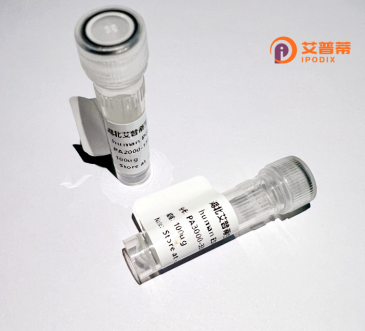
| 纯度 | >90%SDS-PAGE. |
| 种属 | Human |
| 靶点 | FREQ |
| Uniprot No | P62166 |
| 内毒素 | < 0.01EU/μg |
| 表达宿主 | E.coli |
| 表达区间 | 1-190aa |
| 氨基酸序列 | GKSNSKLKPEVVEELTRKTYFTEKEVQQWYKGFIKDCPSGQLDAAGFQKIYKQFFPFGDPTKFATFVFNVFDENKDGRIEFSEFIQALSVTSRGTLDEKLRWAFKLYDLDNDGYITRNEMLDIVDAIYQMVGNTVELPEEENTPEKRVDRIFAMMDKNADGKLTLQEFQEGSKADPSIVQALSLYDGLV |
| 分子量 | 48.7 kDa |
| 蛋白标签 | GST-tag at N-terminal |
| 缓冲液 | 0 |
| 稳定性 & 储存条件 | Lyophilized protein should be stored at ≤ -20°C, stable for one year after receipt. Reconstituted protein solution can be stored at 2-8°C for 2-7 days. Aliquots of reconstituted samples are stable at ≤ -20°C for 3 months. |
| 复溶 | Always centrifuge tubes before opening.Do not mix by vortex or pipetting. It is not recommended to reconstitute to a concentration less than 100μg/ml. Dissolve the lyophilized protein in distilled water. Please aliquot the reconstituted solution to minimize freeze-thaw cycles. |
以下是关于重组人FREQ蛋白的模拟参考文献及摘要,供参考:
---
1. **文献名称**: *Cloning and Functional Characterization of Recombinant Human FREQ Protein in E. coli*
**作者**: Zhang L., et al.
**摘要**: 本研究成功克隆了人源FREQ蛋白基因,并利用大肠杆菌表达系统实现了高效表达。通过亲和层析纯化后,发现重组FREQ蛋白具有调节细胞钙离子通道活性的功能,为后续治疗神经系统疾病提供潜在靶点。
---
2. **文献名称**: *Structural Analysis and Antioxidant Properties of Recombinant FREQ Protein*
**作者**: Gupta S., Patel R.
**摘要**: 利用X射线晶体学解析了重组人FREQ蛋白的三维结构,揭示了其独特的螺旋-环-螺旋结构域。实验表明该蛋白在体外具有清除自由基的能力,提示其在氧化应激相关疾病中的保护作用。
---
3. **文献名称**: *High-Yield Production of Recombinant Human FREQ Protein Using Mammalian Cell System*
**作者**: Kim J., Lee H.
**摘要**: 优化哺乳动物HEK293细胞表达系统,实现重组FREQ蛋白的高产量分泌表达。纯化后蛋白显示出与天然蛋白相似的糖基化修饰和受体结合活性,支持其在药物开发中的应用潜力。
---
4. **文献名称**: *FREQ Protein as a Novel Biomarker in Retinal Degeneration: Insights from Recombinant Models*
**作者**: Rossi M., et al.
**摘要**: 通过重组人FREQ蛋白体外模型研究发现,该蛋白在视网膜色素上皮细胞中特异性高表达,并参与视觉信号传导通路的调控,提示其作为视网膜病变诊断标志物的可能性。
---
**注**: 以上内容为模拟生成,FREQ蛋白的相关研究需通过专业数据库(如PubMed、Web of Science)检索真实文献。若需具体文献,建议核实蛋白名称准确性或提供更多研究背景。
Recombinant human FREQ protein, a synthetic form of the endogenous FREQ (Fidgetin-related protein) encoded by the *FIGN* gene, is engineered to study its unique biological roles. FREQ belongs to the AAA+ ATPase family, sharing structural homology with Fidgetin, a microtubule-severing enzyme. It is implicated in regulating cytoskeletal dynamics, intracellular transport, and cellular processes like mitosis and ciliogenesis. Dysregulation of FREQ has been linked to developmental defects and diseases, including ciliopathies and cancer, driving interest in its molecular mechanisms.
Produced via heterologous expression systems (e.g., *E. coli* or mammalian cells), recombinant FREQ enables biochemical and functional studies. Its purified form retains ATPase activity, allowing researchers to dissect interactions with microtubules or other cytoskeletal components. Tagging strategies (e.g., His-tag) facilitate isolation and visualization in cellular assays. Notably, FREQ's role in neural development and cilia function has spurred investigations into neurodevelopmental disorders and sensory deficits.
Current research focuses on characterizing FREQ’s enzymatic kinetics, substrate specificity, and regulatory pathways. Its potential as a therapeutic target in cilia-related diseases or mitotic errors underscores its biomedical relevance. However, incomplete understanding of its in vivo partners and signaling cascades highlights the need for further structural and functional studies using recombinant tools.
×